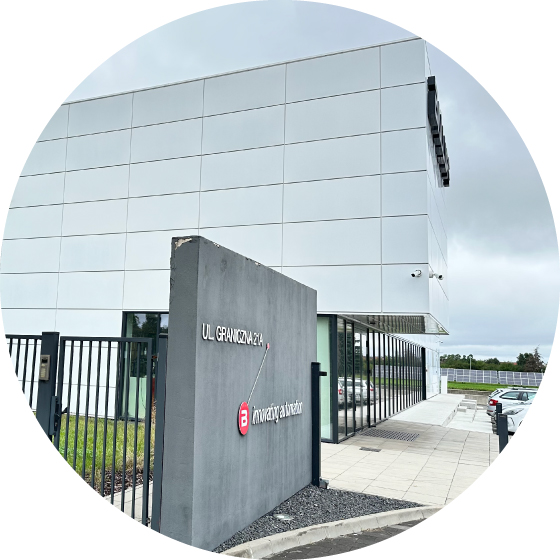Automation for beginners - Balluff guide
Part 2

Reading Time: minutes
Balluff has been sharing its knowledge with students of industrial automation as well as with young engineers who are just beginning their careers. Company representatives are also present at various industry meetings and conferences - but these are not all the activities Balluff undertakes towards education in the field of industrial automation.
In addition to the activities mentioned above, we have created an accompanying handbook. It is called "Automation Basics." In the previous blog article in this series, we introduced the first three topics (the analogy between man and machine, detection methods and making measurements in industrial applications) and convinced readers that one should not stop on the way to acquiring knowledge. Today we will present three more topics.
Lesson 4: Object Identification. RFID systems and barcode readers
One of the most popular industrial automation solutions is object identification. This can be done in several ways, but the most effective are RFID systems and barcode readers. Both of these solutions have their advantages and should always be selected according to the needs of a particular application. By using them in the right configuration, you can not only identify objects, but also increase the efficiency of production quality control, which translates into savings for the plant in terms of reworking or scrapping products as a result of the detection of defects.
The RFID system is also used for product tracking - we have already written about such an application in our blog explaining how RFID is used to track and control milk tanker collections and deliveries. The solution can operate at several frequencies - ultra high frequency (UHF), high frequency (HF) and low frequency (LF). The choice of frequency depends on the specific application and the environmental conditions in which this application operates, such as the proximity of metal components. Barcode readers on the other hand, are designed to work with 1D and 2D codes, and their operating range can reach up to several meters. What else can readers learn about product tracking and object identification?
Asset Tracking, or Product Tracking using RFID and barcode readers. In "Automation Basics," we zoom in on examples of how this technology is used and discuss the various components that make up an RFID system (data carriers, read/write heads and processors).
Work-in-Progress or production control of an automated assembly line through an RFID system. Work-in-Progress allows verification of the progression of the assembly process and its control, also in terms of the error checking of the components used. In this issue we discuss the elements of the RFID system in the context of this type of application and present Balluff devices that correspond to such an application.
Intralogistics - this is the control of the flow of materials with the help of the RFID system, thanks to which the reading and recording of data can take place even at dozens of points in the production line. This allows for even more efficient production and material control. This issue is also presented in terms of product tracking - traceability.
E-Kanban - is a successor to the usual Kanban system, in which cards have been directly replaced by RFID media, the RFID system takes over the reading/writing of data. In this issue we cover the possibilities offered by the installation of such a system and the benefits of its operation for manufacturing companies - including the reliable supply of materials to the production line.
Lesson 5: Network connections. Simple solutions and advanced systems
An extremely important component of systems, without which industrial automation could not exist, is network connections. Network connections perform such a function in a system of sensors and actuators as nerves do in our bodies - they transmit commands, data and critical information about the operation of the entire system of equipment.
As part of the "Automation Basics" tutorial we provide information on how the information generated by sensors is sent to the places where it is later processed or used. We discuss the principles of cables, passive hubs and entire networks that enable data transmission. It's worth remembering that the way sensors are connected is constantly changing (from direct wiring through passive hubs to intelligent network connections). What additional information will readers who are interested in this very issue find?
How the data transfer from the device level to the control level works. We discuss the topic of direct wiring of devices to PLC units, providing the historical background from which network connections emerged. We show what components are necessary to construct an efficient and reliable connection between sensor and controller.
Data collection using passive hubs. We focus on the operation of devices that make it possible to connect multiple wires, sensors and actuators to a housing with a single multicore cable harness. This is what a passive hub is used for - the primary way to reduce wiring and save space.
Data transmission through network modules. In this subsection we mainly present how industrial networks work, which implement the transmission of signals from various devices in a structured way. Readers will also be able to learn about the differences between different types of industrial networks.
Contactless data transmission, here we find an ideal solution for use when there are limitations in using hard wired connections due to either, moving or rotating machine parts, or interchangeable machine parts that contain sensor and actuators.We present you with practical examples of the use of contactless transfer of data, and explain how contactless transmission works.
Lesson 6: IO-Link. Universal, intelligent, easy to use
Our final topic in our "Automation Basics" series is to explain how the IO-Link interface works. It is to industrial automation what the USB interface is to the world of consumer devices - a standardised system for transmitting and reading data, making work much easier. What can readers learn about this interface?
We provide the historical origins of the IO-Link interface, so you are able to understand how the drawbacks of previous systems made it necessary to replace them with a new solution. We present the advantages of the interface: central parameterisation, faster communication between devices and high signal quality.
We present IO-Link in the context of its advertising slogan - "USE". When creating the interface, the manufacturers aimed to create a solution that is universal (Universal), intelligent, enabling parameterisation and diagnostics of devices (Smart) and easy to use (Easy).
We present the devices that are part of the IO-Link system,namely: IO-Link master, which is the heart of the entire system, smart sensors with IO-Link interface - the source of data for the entire system, smart actuators (signal columns and other devices), as well as digital input/output modules for increasing the number of digital and analogue signals.
The above-mentioned topics are only the basics of industrial automation, the scope of which expands to an almost unlimited area. We encourage you to visit the Balluff website and our profile on LinkedIn where you can find the latest information about the company's activities, as well as links to the most recent blog articles.
Keywords
- Industrial automation
- Basics of automation
Author

Balluff Sp. z o.o.
We have been active on the Polish market for more than 25 years. We serve our customers from Pomerania to the Tatra Mountains, providing first-class service and technical support. We are also present online, where we share our knowledge about the latest implementations, industry trends, events or technical aspects of our solutions.
41 Contributions
Comment
Popular posts
What is a capacitive sensor?
How do I wire my 3-wire sensors?
Industrial sensing fundamentals – NPN vs PNP
The industrial revolution - from the steam engine to Industry 4.0
Contact form
Do you have any questions or suggestions? We are at your disposal.
Balluff Limited
-
20 Cheshire Business Park
Cheshire Avenue
Lostock Gralam
Northwich, CW9 7UA
